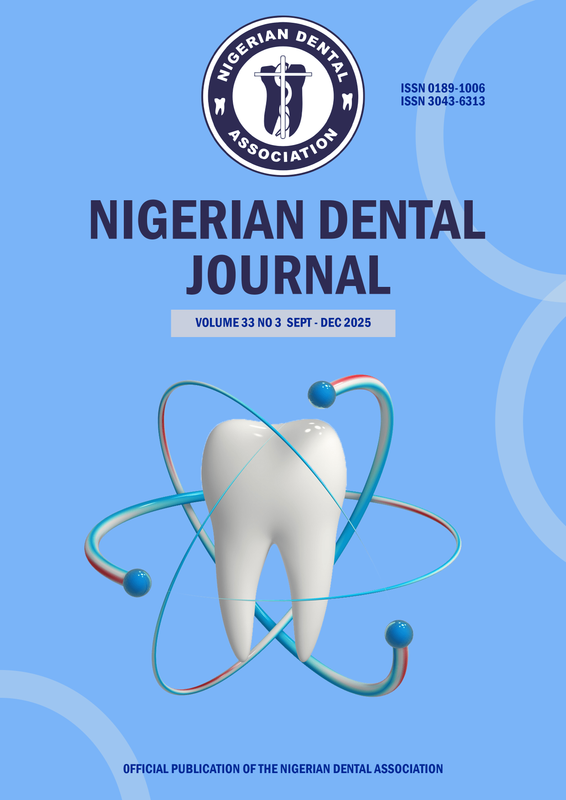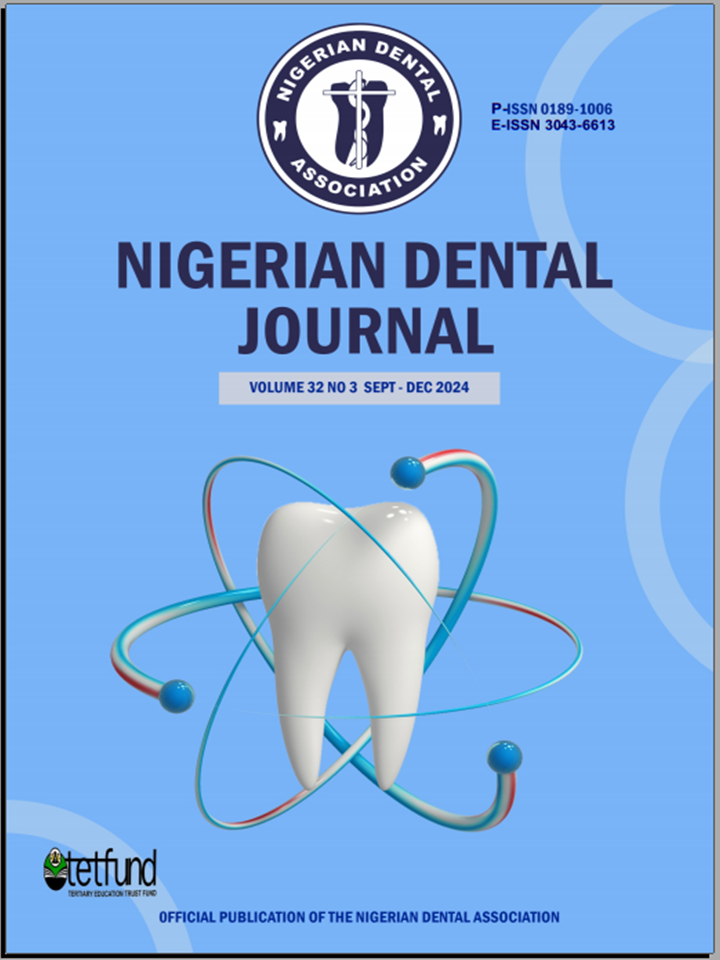Distomolars – Exploring the Rare Clinical Entity in a Northern Nigerian Population
DOI:
https://doi.org/10.61172/jj97qf85Keywords:
Distomolars, Prevalence, Pathologies, Supranumerary teethAbstract
Background: Distomolars are supernumerary teeth erupting distal to the maxillary or mandibular third molars. This present study explored the clinical significance of distomolars in a Nigerian population.
Objectives: The aim of the present study was to estimate the prevalence, clinical significance, and pathologies associated with distomolars in a population of Northern Nigerian adults using dental pantomograms.
Materials and Methods: This retrospective cross-sectional study was conducted in the Department of Oral Diagnostic Sciences, Aminu Kano Teaching Hospital, Kano State, Nigeria, and it included the extraction of images from the central computer attached to the Planmeca Promax machine. The sampling frame included patients who had dental pantomograms during the two-year period under review. The images were viewed on Planmeca Romexis 4.3.0 R software to identify relevant study variables.
Results: Of 4,932 pantomograms reviewed, 107 distomolars were identified. The prevalence of distomolars was 2.17%. The mean age of subjects with a distomolars was 36.25 years, with a male-to-female ratio of 1:1.6. Majority of the distomolars were identified in the maxilla (60.75%) and had typical forms (67.3%) and 72.9% of them were seen unerupted.
Conclusion: Distomolars occurred more frequently in females in the Nigerian population, commoner in the maxilla, and were predominantly unerupted and smaller in size than the normal adjacent teeth.
Downloads
References
. Domín guez Reyes A, Mendoza Mendoza MA, Fernández Domínguez H. Retrospective study of supernumerary teeth in 2,045 patients. Advances in Odontostomatology. 1995;11:575–82.
2. Gorlin R. Dental anomalies and their frequency. En: Gorlin RJ, Cohen MM, Hennekam RCM. In: Syndromes of the head and neck. 4th ed. Oxford University Press; 2001. p. 1224–1126.
3. Developmental Disturbances in Oral and Paraoral structures. In: Shafer’s textbook of oral pathology. 5th Edition. Elsevier; 2009. p. 40.
4. Anthonappa R, King N, Rabie A. Aetiology of supernumerary teeth: A literature review. European Archives of Paediatric Dentistry. 2013;14:279–88.
5. Khalaf K. Supernumerary teeth-review of aetiology, sequelae, diagnosis and management. Part II. International Journal of Advanced Research. 2016;4(11):1363–75.
6. Black GV. Supernumerary teeth. Dental Summary. 1909;29(1):83–110.
7. Mallineni SK. Supernumerary teeth: Review of the literature with recent updates. In Conference Papers in Science; 2014. p. 1–6. Available from: https://doi.org/10.1155/2014/764050
8. Sogi S, Patidar D, Patidar DC, Prasad P. ‘Mesiodentes-A Common Supernumerary in a Unique Appearance’: A Case Report and Literature Review. Journal of Clinical & Diagnostic Research. 2018;12(10):ZD01–3.
9. Patchett C, Crawford P, Cameron A, Stephens C. The management of supernumerary teeth in childhood‐a retrospective study of practice in Bristol dental hospital, England and Westmead dental hospital, Sydney, Australia. International Journal of Paediatric Dentistry. 2001;11(4):259–65.
10. Fernández Montenegro P, Valmaseda-Castellón E, Aytés L, Gay-Escoda C. Retrospective study of 145 supernumerary teeth. Medicina oral, patología oral y cirugía bucal. 2006 Aug 1;11:E339-44.
11. Bamgbose BO, Okada S, Hisatomi M, Yanagi Y, Takeshita Y, Abdu ZS, et al. Fourth molar: A retrospective study and literature review of a rare clinical entity. Imaging Sci Dent. 2019;49(1):27–34.
12. Neville BW, Damm DD, Allen CM, Chi AC. Abnormalities of teeth. In: Oral and Maxillofacial Pathology. 5th ed. Elsevier Health Sciences; 2023. p. 79–80.
13. Ghom AG, Ghom SAL. Textbook of Oral Medicine. 3rd ed. JP Medical Ltd; 2014. p.97.
14. Rajab L, Hamdan M. Supernumerary teeth: review of the literature and a survey of 152 cases. International Journal of Paediatric Dentistry. 2002;12(4):244–54.
15. Nayak G, Shetty S, Singh I, Pitalia D. Paramolar–A supernumerary molar: A case report and an overview. Dent Res J. 2012;9(6):797.
16. Mitchell L, Bennett T. Supernumerary teeth causing delayed eruption—a retrospective study. British journal of orthodontics. 1992;19(1):41–6.
17. Piattelli A, Tete S. Bilateral maxillary and mandibular fourth molars. Report of a case. Acta Stomatologica Belgica. 1992;89(1):57–60.
18. Proff P, Fanghänel J, Allegrini Jr S, Bayerlein T, Gedrange T. Problems of supernumerary teeth, hyperdontia or dentes supernumerarii. Annals of Anatomy-Anatomischer Anzeiger. 2006;188(2):163–9.
19. Harel-Raviv M, Eckler M, Raviv E, Gornitsky M. Fourth molars: A clinical study. Dental Update. 1996;23(9):379–82.
20. Kaya E, Güngör K, Demirel O, Özütürk Ö. Prevalence and characteristics of non‐syndromic distomolars: A retrospective study. Journal of investigative and clinical dentistry. 2015;6(4):282–6.
21. Dang H, Constantine S, Anderson P. The prevalence of dental anomalies in an Australian population. Australian Dental Journal. 2017;62(2):161–4.
22. Martínez-González JM, Cortés-Bretón Brinkmann J, Calvo-Guirado JL, Arias Irimia O, Barona-Dorado C. Clinical epidemiological analysis of 173 supernumerary molars. Acta Odontologica Scandinavica. 2012;70(5):398–404.
23. Gopakumar D, Thomas J, Ranimol P, Vineet DA, Thomas S, Nair VV. Prevalence of supernumerary teeth in permanent dentition among patients attending a dental college in South Kerala: A pilot study. Journal of Indian Academy of Oral Medicine and Radiology. 2014;26(1):42–5.
24. Arslan A, Altundal H, Ozel E. The frequency of distomolar teeth in a population of urban Turkish adults: a retrospective study. Oral Radiology. 2009;25:118–22.
25. Thomas SA, Sherubin E, Pillai KS. A study on the prevalence and characteristics of distomolars among 1000 panoramic radiographs. Journal of Indian Academy of Oral Medicine and Radiology. 2013;25(3):169–72.
26. Kurt H, Suer T, ŞENEL B, Avsever H. A retrospective observational study of the frequency of distomolar teeth in a population of 14.250 patients. Cumhuriyet Dental Journal. 2015;18(4):335–42.
27. Casetta M, Pompa G, Stella R, Quaranta M. Hyperdontia: An epidemiological survey. J Dent Res. 2001;80(4):1295.
28. Scarfe WC, Farman AG, Sukovic P. Clinical applications of cone-beam computed tomography in dental practice. J Can Dent Assoc. 2006;72(1):75.
29. Rahnama M, Szyszkowska A, Pulawska M, Szczerba-Gwozdz J. A rare case of retained fourth molar teeth in maxilla and mandible. Case report. Current Issues in Pharmacy and Medical Sciences. 2014;27(2):118–20.
30. Shahzad KM, Roth LE. Prevalence and management of fourth molars: a retrospective study and literature review. Journal of Oral and Maxillofacial Surgery. 2012;70(2):272–5.
31. Kamal R, Dahiya P, Garg D, Kumar D. Fused primary incisors in siblings: Case report and literature review. Asian pacific Journal of Health Sciences. 2014;1(1):26–30.
32. Mosqueyra VMV, Meléndez MTE, Flores FH. Presence of the fourth molar. Literature review. Revista odontológica mexicana. 2018;22(2):104–18.
33. Esenlik E, Sayın MÖ, Atilla AO, Özen T, Altun C, Başak F. Supernumerary teeth in a Turkish population. American Journal of Orthodontics and Dentofacial Orthopedics. 2009;136(6):848–52.
34. Hattab FN, Alhaija ESA. Radiographic evaluation of mandibular third molar eruption space. Oral Surgery, Oral Medicine, Oral Pathology, Oral Radiology, and Endodontology. 1999;88(3):285–91.
35. Arandi NZ. Distomolars: An overview and 3 case reports. Dent Oral Craniofac Res. 2017;4:1–3.
36. Rani A, Pankaj AK, Diwan RK, Verma R, Rani A, Gupta JP. Prevalence of supernumerary teeth in north Indian population: A radiological study. Int J Anat Res. 2017;5(2.2):3861–5.
37. Kokten G, Balcioglu H, Buyukertan M. Supernumerary fourth and fifth molars: a report of two cases. Journal of Contemporary Dental Practice. 2003;4(4):67–76.
38. Menardía-Pejuan V, Berini-Aytés L, Gay-Escoda C. Supernumerary molars. A review of 53 cases. Bulletin du GIRSO. 2000;42(2):101–5.
39. Cassetta M, Altieri F, Giansanti M, Di-Giorgio R, Calasso S. Morphological and topographical characteristics of posterior supernumerary molar teeth: an epidemiological study on 25,186 subjects. Medicina oral, patologia oral y cirugia bucal. 2014;19(6):e545.
40. Grimanis G, Kyriakides A, Spyropoulos N. A survey on supernumerary molars. Quintessence international. 1991;22(12) p.989.
41. Das S, Suri RK, Kapur V. A supernumerary maxillary tooth: its topographical anatomy and its clinical implications. Folia Morphologica. 2004;63(4):507–9.
42. Dubuk AN, Selvig KA, Tellefsen G, Wikesjo UM. Atypically located paramolar. Report of a rare case. European Journal of Oral Sciences. 1996;104(2):138–40.
Downloads
Published
Issue
Section
License
Copyright (c) 2024 Bernard Emeka OGBOZOR, Sani Abba ABDURRAHMAN, Yahaya ABDURRAHMAN, Abubakar Mohammad KAURA, Anne Nkechi NDUKWE, Babatunde Olamide BAMGBOSE

This work is licensed under a Creative Commons Attribution 4.0 International License.
Open Access Statement
- We became fully Open Access since January 2023.
- Our new and archived materials are available free of charge on open basis and under a Creative Commons license as stated below.
Copyright statement
Copyright © 1999 The authors. This work, Nigerian Dental Journal by Nigerian Dental Association is licensed under Creative Commons Attribution 4.0 International License.


